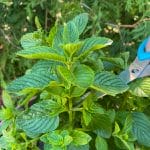How to Harvest Mint – Prune, Dry, Enjoy Your Mint
Learn how to harvest mint to enjoy it year round. Read on to learn how to prune, harvest and dry mint. There are also a few recipe ideas for you to try.
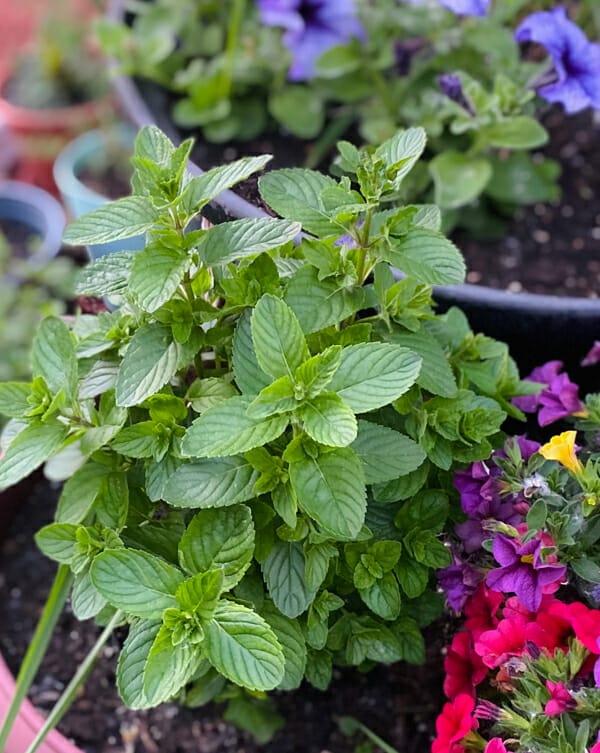
Learn to harvest and prune your: dill, chamomile, rosemary, parsley, chives, chive blossoms, lemon balm & basil.
Mint is a very fast growing herb and can withstand many harvests throughout the season. In fact, when you properly cut back mint, you encourage it to grow fuller and bushier. Never, ever pluck individual leaves here and there. Plucking leaves at random will, over time, weaken the plant as you slowly strip it bare.
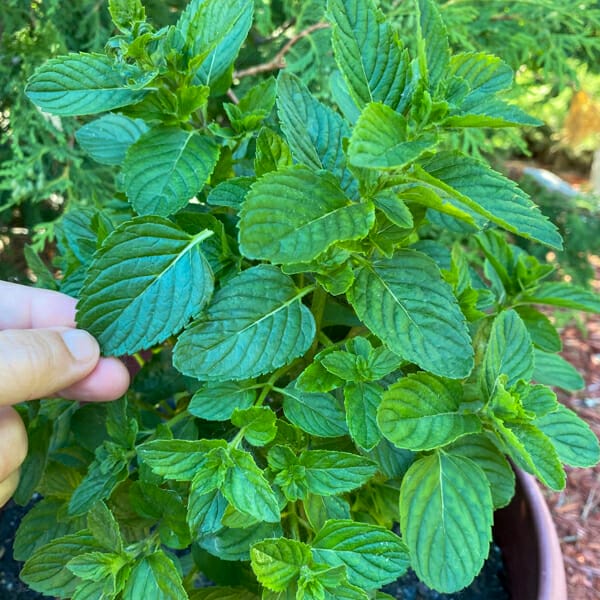
Instead of plucking individual leaves, collect the tips of each stem of mint.
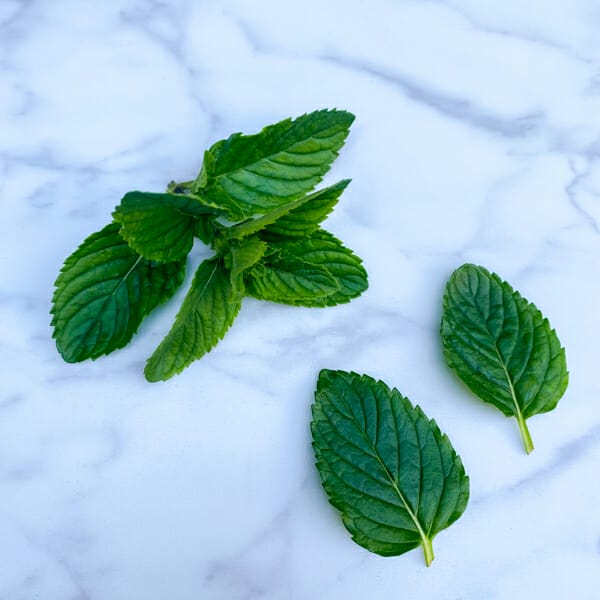
How to Harvest Mint
Harvesting sounds like there should be one day at the end of the season where you cut all the mint at once. That’s not the best strategy for mint or most herbs. It’s best if you harvest or prune your mint all season long. I start harvesting as early as June to encourage growth and harvest tasty, beautiful mint before it flowers or the bugs get at it.
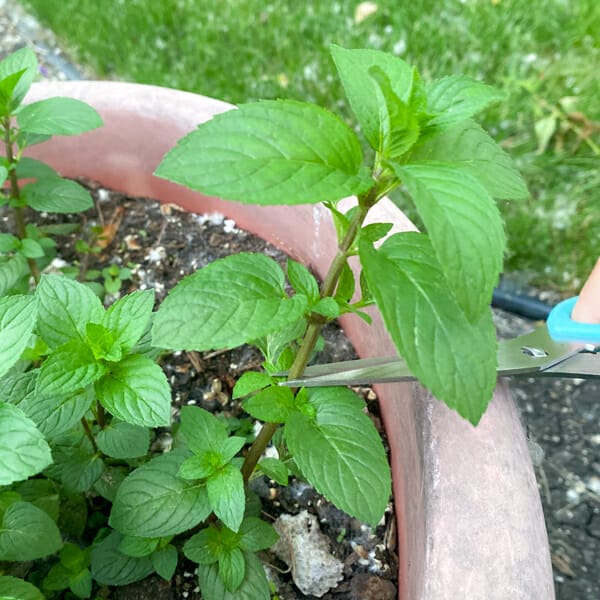
When to Harvest
- Harvest mint all summer long starting in late spring to encourage full, bushy growth.
- Harvest before flowers develop to get the most flavourful mint. This is when the plant has the most essential oils. But don’t worry, if you miss it, you’ll still get flavor from mint harvested after blossoming.
- Harvest mid morning – after the dew has evaporated but before the heat of the day causes the essential oils to fade.
Where to Cut
- Moving from the top down along a stem, cut just above where two leaves join the stem. In the crook where the leaves meet the stem, you may see shoots starting to grow. By cutting the stem, just above this spot, you’ll encourage those shoots to grow faster and fuller.
- You can cut just the tip or you can cut a little further down the stem.
- Leave at least two sets of leaf junctions from the ground up so the mint plant stays strong and healthy.
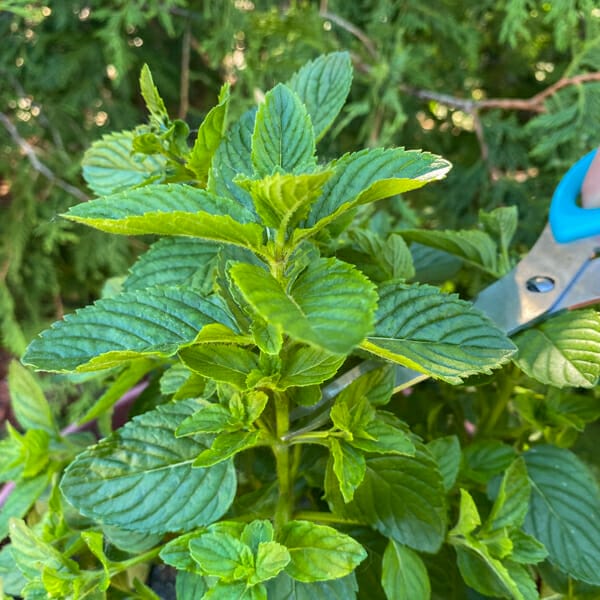
How to Harvest Mint
Ingredients
- 1 plant Mint (chocolate, peppermint, spearmint or other varieties) with full bushy leaves
Instructions
- Moving from the top down along a stem, cut just above where two leaves join the stem.
- In the crook where the leaves meet the stem, you may see shoots starting to grow. By cutting the stem, just above this spot, you'll encourage those shoots to grow faster and fuller.
- You can cut just the tip or you can cut a little further down the stem. Leave at least two sets of leaf junctions from the ground up so the mint plant stays strong and healthy.
Video
Notes
How to Store Fresh Mint
If you want to use your freshly harvested mint over a couple of days here are two ways to keep it as fresh as possible. Either method will keep mint fresh for 7-10 days. Bouquet Style – Store your mint stems in a jar of water, just like you would a bouquet of flowers. Avoid putting leaves in the water, just the stems. If you keep your bouquet in the fridge it will last a little longer than on the counter top, although that will work too. Wrap Style – Wash and pat dry. Roll in a slightly damp paper or cotton towel. Place in plastic bag but do not seal. Keep in crisper drawer of fridge. Be sure the inside of the bag does not get too damp, replace with a dry towel if that happens.The Video – How to Harvest and Dry Mint
How to Store Fresh Mint
If you want to use your freshly harvested mint over a couple of days here are two ways to keep it as fresh as possible. Either method will keep mint fresh for 7-10 days.
Bouquet Style – Store your mint stems in a jar of water, just like you would a bouquet of flowers. Avoid putting leaves in the water, just the stems. If you keep your bouquet in the fridge it will last a little longer than on the counter top, although that will work too.
Wrap Style – Wash and pat dry. Roll in a slightly damp paper or cotton towel. Place in plastic bag but do not seal. Keep in crisper drawer of fridge. Be sure the inside of the bag does not get too damp, replace with a dry towel if that happens.
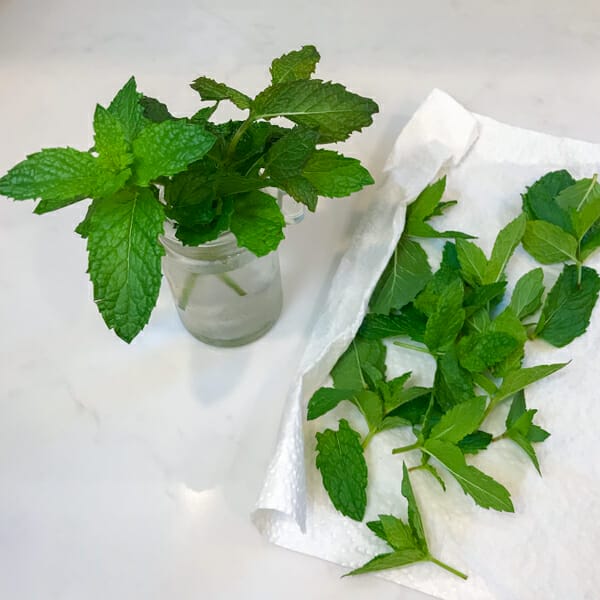
How to Dry Mint
Here are my two favourite ways to dry mint that don’t involve any machines! For dehydrating mint – read How to Dry Mint in the Dehydrator for tips on using the microwave or oven get my ebook From Garden to Table:Everyday Cooking with Herbs.
Start by Washing & Drying
Wash and pat dry your mint to remove any surface moisture.
Wash your mint by swishing in a bowl of water. Remove any yellow or blemished leaves.
Dry mint by gently patting it and laying on a clean towel to remove any surface moisture. Water droplets will cause the leaves to turn dark brown or black when hung to dry, so try to remove as much moisture as you can. Let them rest on the towel for a couple of hours or even overnight.
Hang dry…
- Gather 5-6 stems and tie together with kitchen string. To allow for good air circulation, do not tie too many stems together.
- Label your mint and hang in a clean, dry and dark place.
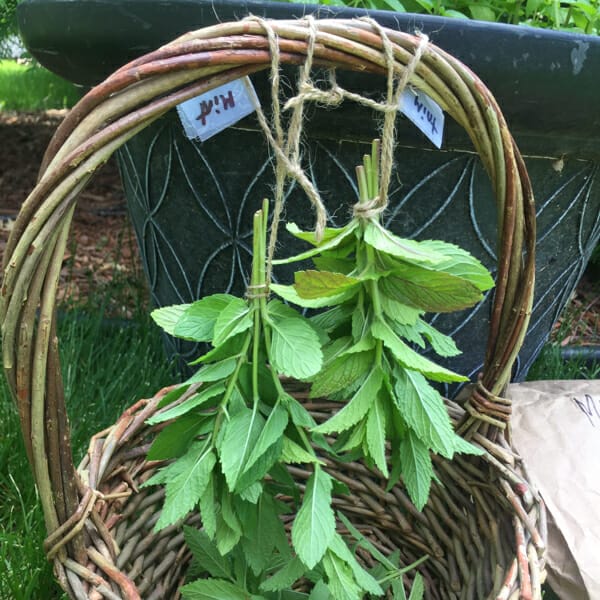
In a paper bag…
If you have a small handful of mint that doesn’t have long stems for tying, use a paper bag.
- Dry mint very well after washing, by leaving out overnight. There cannot be any surface moisture when drying herbs in a bag.
- Loosely toss mint in a paper bag (never plastic). Do not overcrowd the bag, there should be lots of room for air circulation.
- Roll up paper bag leaving plenty of air space around the mint.
- Store in a dry, dark space for 1-2 weeks.
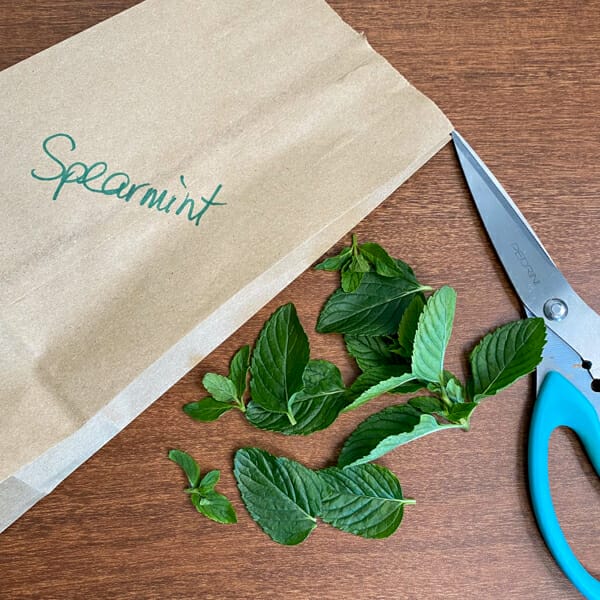
How to Store Dried Mint
To store your mint, keep the leaves and stems in big pieces to retain as much flavor as possible. Store in paper bags or glass jars (avoid plastic bags as they may lead to condensation). Only when you’re ready to use your herbs should you crumble them up to release their essence.
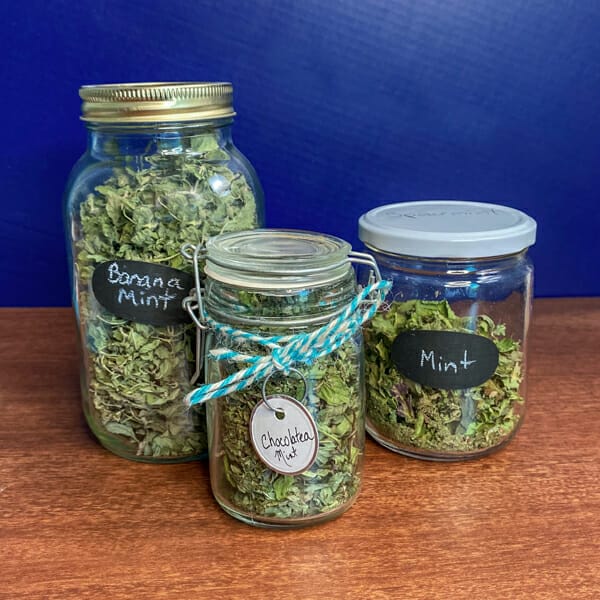
Types of Mint
The great thing about mint is that it comes in so many different varieties. You’ll find mint that grows tall and is dark green with dark red stems and mint that is lime green or variegated and grows low to the ground. No matter what size, color or shape of leaves all mints have a square stem and are pruned or harvested the same way.
Peppermint – the strongest menthol flavour – that intense cool minty flavor ideal for soothing coughs and colds
Spearmint – a sweeter less intense minty flavor, perfect for cooking (eg. Tabbouleh salad, Falafel salad bowl) and improving digestion
Chocolate Mint – truly tastes like chocolate mint wafers (the parent plant is peppermint)
Apple, Orange, Banana, Pineapple, Strawberry or Grapefruit Mint – some actually taste like their name suggests, others not so much, but they’re all fun to try and make great iced teas
Mojito Mint – the classic mint for muddling and making Mojitos – Watch How to Harvest Mojito Mint
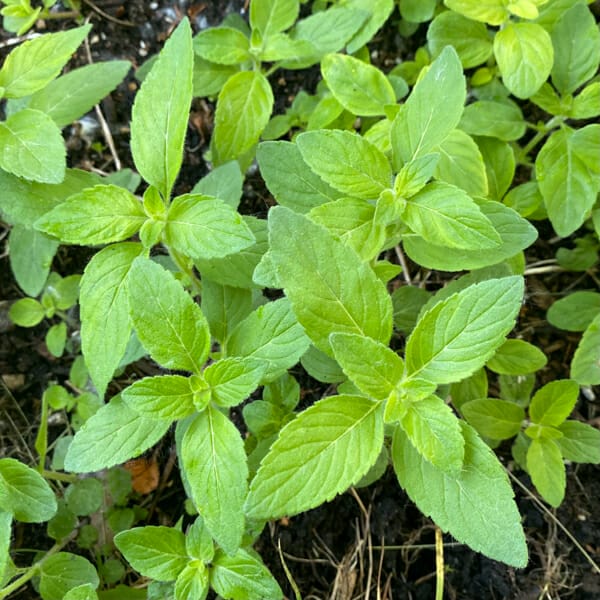
Using and Enjoying Mint
Mint is a very versatile herb that can be used in sweet and savoury dishes. Here are a few of my favourite recipes using mint.
If a recipe simply calls for mint, choose spearmint, it is the most commonly used cooking mint. Peppermint will have an overpowering menthol (think cough candy) flavour and other mints will introduce other flavours – not necessarily bad, but likely not what the recipe developer had in mind.
- Tabbouleh – Parsley & Mint Salad with Bulgur
- Orange and Mint Salad
- Falafel Salad Bowl with Quinoa
- Watermelon, Cucumber and Feta Salad
- Green Peas with Butter & Mint
- Raspberry Mint Jam
- Herb Infused Simple Syrups – perfect for Cocktails and Mocktails
- Brewing Tea with Fresh or Dried Herbs
- Kale and Apple Smoothie – add mint to any of your smoothie
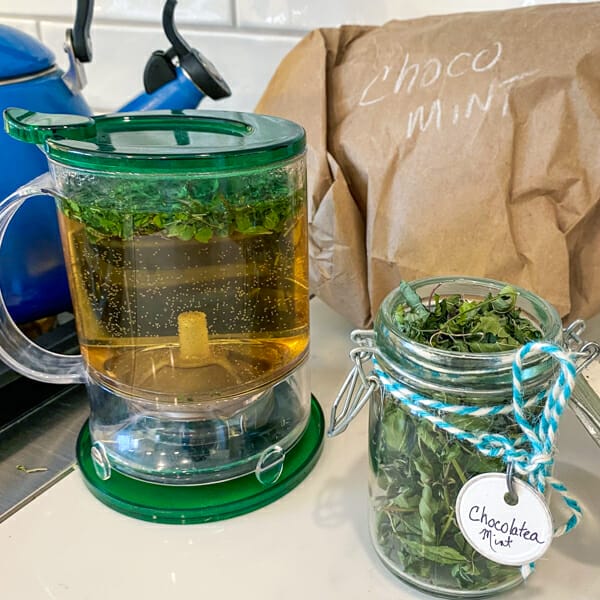
I’d love to hear what type of mint you enjoy growing and how you use it. Leave a comment below or tag me on Instagram at #getgettys or Facebook @GettyStewart.HomeEconomist.
Sign up to get articles by Getty delivered to your inbox. You’ll get recipes, practical tips and great food information like this. Getty is a Professional Home Economist, speaker and writer putting good food on tables and agendas. She is the author of Manitoba’s best-selling Prairie Fruit Cookbook, Founder of Fruit Share, a mom and veggie gardener.


